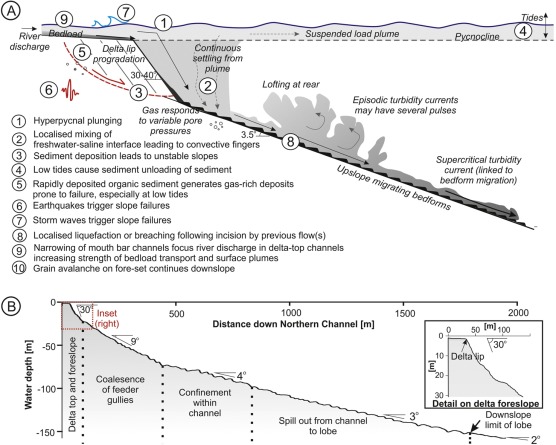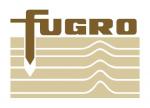Landslide and sediment flow risk in fjord deltas - new paper published
Rivers and subaqueous flows of sediment known as turbidity currents, are the two most important sediment transport processes by volume on Earth. These processes pose hazards to a wide range of seafloor and coastal infrastructure. Various hypotheses have been proposed for triggering of turbidity currents offshore from river mouths, including direct plunging of river discharge, delta mouth bar flushing or slope failure caused by low tides and gas expansion, earthquakes and rapid sedimentation. During 2011, 106 turbidity currents were monitored at Squamish Delta, British Columbia. This enabled statistical analysis of timing, frequency and triggers. The largest peaks in river discharge did not create hyperpycnal flows. Instead, delayed delta-lip failures occurred 8–11 hours after flood peaks, due to cumulative delta top sedimentation and tidally-induced pore pressure changes. Elevated river discharge is thus a significant control on the timing and rate of turbidity currents but not directly due to plunging river water. Elevated river discharge and focusing of river discharge at low tides cause increased sediment transport across the delta-lip, which is the most significant of all controls on flow timing in this setting.
We have just published the findings of this study in the journal Earth and Planetary Science Letters, which has relevance for a range of seafloor infrastructure that may be installed in fjords, such as telecommunication cables, oil and gas pipelines. The study is also important for coastal infrastructure, as subaqueous landslide-triggered tsunamis can be damaging, and have caused loss of life in the past. The paper can be found here and the full reference is: Clare, M. A., Clarke, J. H., Talling, P. J., Cartigny, M. J. B., & Pratomo, D. G. (2016). Preconditioning and triggering of offshore slope failures and turbidity currents revealed by most detailed monitoring yet at a fjord-head delta. Earth and Planetary Science Letters, 450, 208-220.
Below: (A) Previous hypotheses for triggering of slope failures and turbidity currents at fjord-head deltas with bedload-dominated rivers. (B) Water depth and slope angles based on Squamish delta slope.





